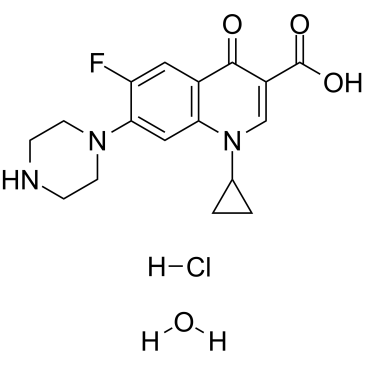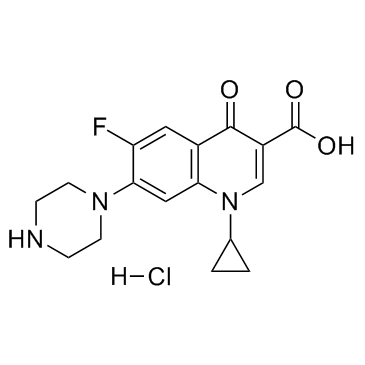Ciprofloxacin Hydrochloride hydrate

Ciprofloxacin Hydrochloride hydrate structure
|
Common Name | Ciprofloxacin Hydrochloride hydrate | ||
|---|---|---|---|---|
| CAS Number | 86393-32-0 | Molecular Weight | 385.818 | |
| Density | N/A | Boiling Point | 581.8ºC at 760 mmHg | |
| Molecular Formula | C17H21ClFN3O4 | Melting Point | 318-320 °C | |
| MSDS | Chinese USA | Flash Point | 305.6ºC | |
Use of Ciprofloxacin Hydrochloride hydrateCiprofloxacin hydrochloride is a fluoroquinolone antibiotic, exhibiting potent antibacterial activity. |
| Name | ciprofloxacin hydrochloride hydrate |
|---|---|
| Synonym | More Synonyms |
| Description | Ciprofloxacin hydrochloride is a fluoroquinolone antibiotic, exhibiting potent antibacterial activity. |
|---|---|
| Related Catalog | |
| In Vitro | Ciprofloxacin (hydrochloride monohydrate) is a fluoroquinolone antibiotic, exhibiting potent antibacterial activity[1]. Ciprofloxacin (hydrochloride monohydrate) (CIP) shows potent activity against Y. pestis with MIC90 of 0.03 μg/mL[2]. |
| In Vivo | Ciprofloxacin (hydrochloride monohydrate) (1 mg/L) induces glutathione-S-transferase (GST) activity, in contrast with inhibited GST and Catalase (CAT) of larvae exposed to enrofloxacin. Ciprofloxacin (hydrochloride monohydrate) (≥10 μg/L) is ecotoxic for development, growth, detoxifying, and oxidative stress enzymes in anuran amphibian larvae[1]. In a murine model of pneumonic plague, Ciprofloxacin (hydrochloride monohydrate) (30 mg/kg, i.p.) results in a drug exposure which is similar to the drug exposure observed in human following a 500 mg dose of oral Ciprofloxacin (hydrochloride monohydrate). Intraperitoneal Ciprofloxacin (hydrochloride monohydrate) reduces the lung bacterial load compare to controls treated with intraperitoneal PBS[3]. |
| Cell Assay | Bacterial inocula are prepared by suspending colonies into Mueller-Hinton broth (CAMHB) (containing Ciprofloxacin (hydrochloride monohydrate)) from 18 to 24 h (B. anthracis) or 42 to 48 h (Y. pestis) on sheep blood agar (SBA) plates that are incubated at 35°C. Suspended cultures are diluted with CAMHB to a bacterial cell density of 105 CFU/mL adjusted based on the optical density at 600 nm. To each well of the 96-well plate, 50 μL of dilutions is added for a final inoculum of ~5×104 CFU/well. Plates are incubated at 35°C. MICs are determined visually at 18 to 24 h (B. anthracis) or 42 to 48 h (Y. pestis) and also by absorbance at 600 nm[2]. |
| Animal Admin | Female BALB/cAnNCrl (BALB/c) mice, 8 to 10 weeks old and 20 g (±4 g) are used in this assay. A single dose of Ciprofloxacin (hydrochloride monohydrate) (30 mg/kg) is administered to mice (n=30) via the intraperitoneal (i.p.) route. The mice (n=3/time point/group) are culled at 1, 10, 20, or 30 min and 1, 1.5, 2, 4, 8, 12 h following Ciprofloxacin (hydrochloride monohydrate) administration and 1, 15, or 30 min and 1, 2, 4, 6, 10, 18, or 24 h following DRCFI or CFI administration. Blood sampling points are chosen based upon the short half-life of Ciprofloxacin (hydrochloride monohydrate) and longer half-life of CFI. Blood and lungs (whole organ) are collected post mortem for analysis. The lung doses following CFI or DRCFI administration are calculated using the concentration of Ciprofloxacin (hydrochloride monohydrate) in the lung samples at 1 min post-administration[3]. |
| References |
| Boiling Point | 581.8ºC at 760 mmHg |
|---|---|
| Melting Point | 318-320 °C |
| Molecular Formula | C17H21ClFN3O4 |
| Molecular Weight | 385.818 |
| Flash Point | 305.6ºC |
| Exact Mass | 385.120453 |
| PSA | 83.80000 |
| LogP | 2.71480 |
| Storage condition | 0-6°C |
| Hazard Codes | Xi |
|---|---|
| Risk Phrases | R36/37/38:Irritating to eyes, respiratory system and skin . |
| Safety Phrases | S26-S36/37/39 |
| RIDADR | NONH for all modes of transport |
| HS Code | 2933990090 |
| Precursor 0 | |
|---|---|
| DownStream 1 | |
| HS Code | 2933990090 |
|---|---|
| Summary | 2933990090. heterocyclic compounds with nitrogen hetero-atom(s) only. VAT:17.0%. Tax rebate rate:13.0%. . MFN tariff:6.5%. General tariff:20.0% |
|
Gingival pain: an unusual side effect of ziprasidone.
BMJ Case Rep. 2013 , doi:10.1136/bcr-2012-007577, (2013) The patient is a 52-year-old man with schizophrenia who developed severe, unremitting gingival pain after his ziprasidone dosage was increased from 80 to 120 mg. His physical examination and laborator... |
|
|
Comparative study of the effects of antituberculosis drugs and antiretroviral drugs on cytochrome P450 3A4 and P-glycoprotein.
Antimicrob. Agents Chemother. 58(6) , 3168-76, (2014) Predicting drug-drug interactions (DDIs) related to cytochrome P450 (CYP), such as CYP3A4 and one of the major drug transporters, P-glycoprotein (P-gp), is crucial in the development of future chemoth... |
|
|
Decrease in ciprofloxacin absorption by polyvalent metal cations is not fully attributable to chelation or adsorption.
Drug Metab. Pharmacokinet. 29(5) , 414-8, (2014) The drug interaction between new quinolone antibiotics (NQs) and polyvalent metal cation products, leading to a significant decrease in the absorption of NQ, is considered to be attributable to the fo... |
| 1-Cyclopropyl-6-fluoro-4-oxo-7-(piperazin-1-yl)-1,4-dihydroquinoline-3-carboxylic acid hydrochloride hydrate |
| 1-cyclopropyl-6-fluoro-4-oxo-7-piperazin-1-ylquinoline-3-carboxylic acid,hydrate,hydrochloride |
| Flociprin |
| Ciprobay |
| acide 1-cyclopropyl-6-fluoro-4-oxo-7-pipérazin-1-yl-1,4-dihydroquinoléine-3-carboxylique chlorhydrate hydrate |
| Cipro |
| Ciloxan |
| Ciproxan |
| 1-Cyclopropyl-6-fluor-4-oxo-7-piperazin-1-yl-1,4-dihydrochinolin-3-carbonsäurehydrochloridhydrat |
| 1-Cyclopropyl-6-fluoro-4-oxo-7-(1-piperazinyl)-1,4-dihydro-3-quinolinecarboxylic acid hydrochloride hydrate |
| 3-Quinolinecarboxylic acid, 1-cyclopropyl-6-fluoro-1,4-dihydro-4-oxo-7-(1-piperazinyl)-, hydrochloride, hydrate (1:1:1) |
| Septicide |
| MFCD00079044 |
| Ciprofloxacin hydrochloride hydrate |
| Ciflox |
| Ciprofloxacin Hydrochloride Monohydrate |
| Ciprofloxacin Hydrochloride |
| BAY O 9867 |
| 1-cyclopropyl-6-fluoro-4-oxo-7-piperazin-1-yl-1,4-dihydroquinoline-3-carboxylic acid hydrochloride hydrate |
| Baycip |
| ciprofloxacin monohydrochloride monohydrate |
 CAS#:93107-08-5
CAS#:93107-08-5
